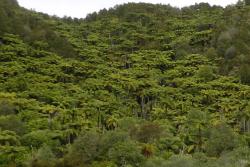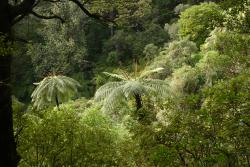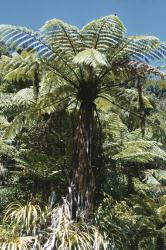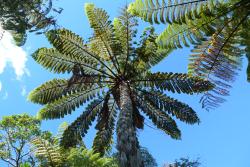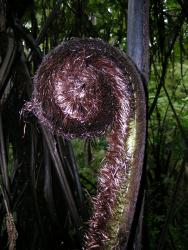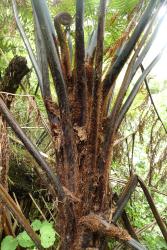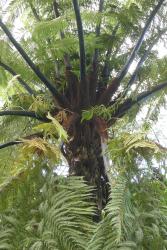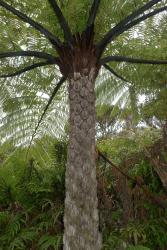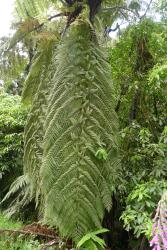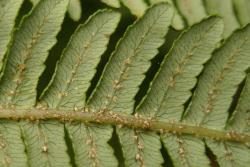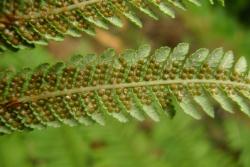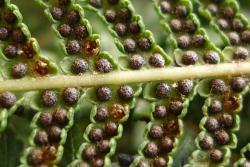- ≡ Polypodium medullare G.Forst., Pl. Esc. 74 (1786)
- ≡ Sphaeropteris medullaris (G.Forst.) Bernh., J. Bot. (Schrader) 1800(2): 122 (1801)
- = Cyathea medullaris var. integra Hook., Sp. Fil. 1, 27 (1844)
- = Cyathea polyneuron Colenso, Trans. & Proc. New Zealand Inst. 11: 429 (1879)
- ≡ Cyathea medullaris var. polyneuron (Colenso) C.Chr., Index Filic. 194 (1905)
Rhizomes erect, forming a woody trunk up to c. 20 m tall, 150–300 mm in diameter, covered in black, hexagonal stipe scars; bearing scales near the apex. Rhizome scales conform, acicular, bearing dark-coloured setae on margins, blackish-brown, shining. Fronds 3000–5000 mm long, arching upwards from the crown; dead fronds usually falling, but up to 5 occasionally persistent. Stipes 160–1650 mm long, 40–95 mm wide and 40–60 mm deep at the base, black, sometimes becoming dark brown distally, weakly tuberculate and slightly rough; blackish-brown or dark brown scales with dark-coloured setae on margins densely covering base of stipe, up to 50 mm long and 2 mm wide, becoming pale brown, smaller and more scattered distally. Laminae deeply 2-pinnate-pinnatifid to 3-pinnate-pinnatifid, elliptic or obovate, 3000–4000 mm long, 600–2000 mm wide, dark green on adaxial surface, pale green on abaxial surface, coriaceous; adaxial surfaces of rachis and primary pinna midribs abundantly covered in fine, acicular, colourless or pale brown hairs up to 1 mm long, more scattered on secondary pinna midribs and tertiary pinnae; abaxial surfaces bearing ovate scales with attenuate apices and dark red marginal and apical setae, up to 2 mm long and 1 mm wide on the pinna midribs, and acicular scales up to 5 mm long and 0.5 mm wide on the rachis; rachis blackish-brown on abaxial surface, becoming yellow-brown or pale brown distally, often yellow-brown or yellow-green or green on adaxial surface especially when young, tuberculate. Primary pinnae in 20–25 pairs, ovate, narrowly ovate or narrowly triangular; the longest at or above the middle, 350–950 mm long, 125–300 mm wide, short to long-stalked, abaxial surfaces of costae tuberculate. Secondary pinnae narrowly ovate or narrowly triangular, the longest 65–185 mm long, 12–37 mm wide, short-stalked or sessile. Longest tertiary pinnae 7–20 mm long, 2–4 mm wide, adnate to decurrent; apices acute; margins serrate or divided up to half way to costa. Sori 0.7–1.1 mm in diameter; paraphyses as long as sporangia; indusia completely covering sori before maturity, splitting irregularly at maturity.
In the field Cyathea medullaris is readily distinguished by its tall trunk with black hexagonal stipe scars, and large arching fronds with thick black stipes. The lamina and stipe scales have dark red setae along both margins, which distinguishes this species from all other native species. Even very young plants of C. medullaris can be positively identified by this character. The naturalised C. cooperi has similar scales but is distinguished by its pale brown stipes and exindusiate sori. Plants of C. cunninghamii are superficially similar to C. medullaris but have more slender trunks covered in appressed stipe bases, shorter and more lacy fronds, and thinner stipes. C. cunninghamii also has scales that lack the marginal setae, and indusia that open to form a hood-shape, rather than splitting open irregularly.
North Island: Northland, Auckland, Volcanic Plateau, Gisborne, Taranaki, Southern North Island.
South Island: Western Nelson, Sounds-Nelson, Marlborough, Westland, Canterbury, Southland, Fiordland.
Three Kings Islands, Chatham Islands, Stewart Island.
Altitudinal range: 0–650 m.
Cyathea medullaris occurs primarily in coastal and lowland forest throughout much of the North Island, extending locally into montane forest. It ranges from sea level to 550 m near Taihape, and to 650 m in the Raukūmara and Kaweka Ranges. In the South Island it occurs in coastal and lowland districts of north-west Nelson and the Marlborough Sounds, extending sporadically on the west coast to Fiordland and Southland, and on the east coast to Banks Peninsula. It is absent from Otago and inland areas of Canterbury and Marlborough. It reaches 400 m on Banks Peninsula and 450 m at Blue Duck Reserve in the Seaward Kaikoura Range. It occurs also on the Three Kings Islands and Chatham Islands. There is a 19th century collection from Stewart Island (WELT P005625), but Wilson (1982) states it is "rare and local, as far south as Port Adventure".
Also occurs in Fiji, Samoa, Tahiti, Marquesas Islands, Austral Islands and Pitcairn Island (Holttum 1964). Whether the Pacific Islands’ populations are genuinely conspecific with those in New Zealand requires investigation.
The species is reported to be naturalised in the Azores (Lehnert, pers. comm. 2011).
Cyathea medullaris is a tall emergent species that occurs mostly in broadleaved forest, but also in podocarp, beech and kānuka forest and under introduced conifers and Salix species. It can be abundant in the initial forest formed on slips and other disturbed sites undergoing regeneration. It is a frost-tender species, and prefers damp habitats.
n = 69 (Brownlie 1961).
Cyathea polyneuron was described by Colenso (1879) from a plant he originally collected on Scinde Island, Napier. There are specimens in the Colenso Herbarium at WELT (P003306), in the Cheeseman Herbarium (AK 143439), and on two sheets at K. However, Allan (1961, p. 41) lectotypified the specimen at WELT, stating "the type in WELT consists of three portions of a rachis bearing in all 20 secondary pinnae…", a description which accurately relates to WELT P003306 (now on two sheets).
Cyathea medullaris var. integra was described by Hooker (1844–1846) from specimens collected by Colenso in New Zealand, but no material has been located at AK, K or WELT, which hold most of Colenso’s collections, and the type has been left undesignated (Brownsey & Perrie 2015).



